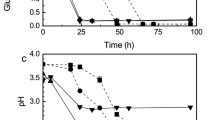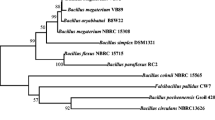Abstract
A locally isolated Gram-negative bacterium, Cupriavidus sp. USMAA2-4 was found capable of producing terpolymer poly(3-hydroxybutyrate-co-3-hydroxyvalerate-co-4-hydroxybutyrate) [P(3HB-co-3HV-co-4HB)] using γ-butyrolactone or 1,4-butanediol with either valeric acid or 1-pentanol as the carbon source. The present of 3HB, 3HV and 4HB monomers were confirmed by gas chromatography (GC) and nuclear magnetic resonance (NMR) analysis. PHA concentration of 1.9 g/l was the highest value obtained using the combination of 1,4-butanediol and 1-pentanol through one-step cultivation process. PHA concentration obtained through two-step cultivation process was higher for all the combinations and the highest value achieved was 2.5 g/l using γ-butyrolactone and 1-pentanol as carbon source. Various molar fractions of 4HB and 3HV ranging from 6 to 14 mol% and 39 to 87 mol%, respectively were produced through two-step cultivation process by manipulating the concentration of γ-butyrolactone. As the culture aeration was reduced, the molar fraction of 3HV and 4HB increased from 40 to 67 mol% and 10 to 24 mol%, respectively while the dry cell weight and PHA content decreased. The terpolymer produced was characterized using gel permeation chromatography (GPC) and differential scanning calorimetry (DSC). The number-average molecular weight (M n) and the melting temperature (T m)) of the terpolymer were in the range of 177–484 kDa and 160–164°C, respectively.



Similar content being viewed by others
References
Amirul AA, Yahya ARM, Sudesh K, Azizan MNM, Majid MIA (2008a) Biosynthesis of poly(3-hydroxybutyrate-co-4-hydroxybutyrate) copolymer by Cupriavidus sp. USMAA1020 isolated from Lake Kulim, Malaysia. Bioresour Technol 99:4903–4909
Amirul AA, Syairah SN, Yahya ARM, Azizan MNM, Majid MIA (2008b) Synthesis of biodegradable polyesters by Gram-negative bacterium from Malaysian environment. World J Microbiol Biotechnol 24(8):1327–1332
Anderson AJ, Dawes EA (1990) Occurrence, metabolic role and industrial use of bacteria polyhydroxylalkanoates. Microbiol Rev 54:450–472
Braunegg G, Sonnleitner B, Lafferty RM (1978) A rapid gas chromatographic method for the determination of poly-β-hydroxybutyric acid in microbial biomass. Eur J Appl Microbiol Biotechnol 6:29–37
Braunegg G, Lefebvre G, Genser KF (1998) Polyhydroxyalkanoates, biopolyesters from renewable resources: physiological and engineering aspects. J Biotechnol 65:127–161
Dawes EA, Senior PJ (1973) The role and regulation energy reserve polymers in microorganisms. In: Rose AH, Tempest DW (eds) Advances in microbial physiologically. Acad Press, London, p 140
Doi Y, Kunioka M, Nakamura Y, Soga K (1986) Nuclear magnetic resonance studies on poly (β-hydroxybutyrate and a copolyester of β-hydroxybutyrate and β-hydroxyvalerate isolated from Alcaligenes eutrophus H16. Macromol 19:2860–2864
Fukui T, Kichise T, Yoshida Y, Doi Y (1997) Biosynthesis of poly(3-hydroxybutyrate-co-3-hydroxyvalerate-co-3-hydroxyheptanoate) terpolymers by recombinant Alcaligenes eutropus. Biotechnol Lett 19(11):1093–1097
Grothe E, Young MM, Chisti Y (1999) Fermentation optimization for the production of poly(β-hydroxybutyric acid) microbial thermoplastic. Enzyme Microb Technol 25:132–141
Huisman GW, Wonink E, Meima R, Kazemier B, Terpstra P, Witholt B (1991) Metabolism of poly(3-hydroxyalkanoates) (PHAs) by Pseudomonas oleovorans. Identification and sequence of genes and function of the encode proteins in the synthesis and degradation of PHA. J Biol Chem 266:2191–2198
Kimura H, Yoshida Y, Doi Y (1992) Production of poly(3-hydroxybutyrate-co-4-hydroxybutyrate) by Pseudomonas acidovorans. Biotechnol Lett 14:445
Kunioka M, Nakamura Y, Doi Y (1988) New bacterial copolyesters produced in Alcaligenes eutrophus from organic acids. Polym Commun 29:174–176
Lee WH, Azizan MNM, Sudesh K (2004) Effects of culture conditions on the composition of poly(3-hydroxybutyrate-co-4-hydroxybutyrate) synthesized by Comamonas acidovorans. Polym Degrad Stab 84:129–134
Lee WH, Loo CY, Nomura CI, Sudesh K (2008) Biosynthesis of polyhydroxyalkanaote copolymers from mixtures of plant oils and 3-hydroxyvalerate precursors. Bioresour Technol 99:6844–6851
Lemos PC, Serafirm LS, Reis MAM (2006) Synthesis of polyhydroxyalkanoates from different short-chain fatty acids by mixed cultures submitted to aerobic dynamic feeding. Biotechnol 122:226–238
Madden LA, Anderson AJ, Asrar J, Berger P, Garrett P (2000) Production and characterization of poly(3-hydroxybutyrate-co-3-hydroxyvalerate-co-4-hydroxybutyrate) synthesized by Ralstonia eutropha in fed-batch cultures. Polym 41:3499–3505
Madison LL, Huisman GW (1999) Metabolic engineering of poly(3-hydroxylalkanoates): from DNA to plastic. Microbiol Mol Biol Rev 63:21–53
Marchessault RH (1996) Tender morsels for bacteria: recent development in microbial polyesters. Trends Polym Sci 4:163–168
Mukhopadhyay M, Patra A, Paul AK (2005) Production of poly(3-hydroxybutyrate) and poly(3-hydroxybutyrate-co-3-hydroxyvalerate) by Rhodopseudomonas palustris SP5212. World J of Microbiol Biotechnol 21:765–769
Park SJ, Ahn WS, Green PR, Lee SY (2001) Biosynthesis of poly(3-hydroxybutyrate-co-3-hydroxyvalerate-co-3-hydroxyhexanoate) by metabolically engineered Escherichia coli strains. Biotechnol Bioeng 74(1):81–86
Peoples OP, Sinskey AJ (1989) Poly-beta-hydroxybutyrate (PHB) biosynthesis in Alcaligenes eutrophus H16: identification and characterization of the PHB polymerase gene (phbC). J Biol Chem 264:15298–15303
Rahayu A, Zaleha Z, Yahya ARM, Majid MIA, Amirul AA (2008) Production of copolymer poly(3-hydroxybutyrate-co-4-hydroxybutyrate) through a one-step cultivation process. World J Microbiol Biotechnol 24:2403–2409
Reddy CSK, Ghai R, Rashmi KVC (2003) Polyhydroxyalkanoate—an overview. Bioresour Technol 87:137–146
Saito Y, Doi Y (1994) Microbial synthesis and properties of poly(3-hydroxybutyrate-co-4-hydroxybutyrate) in Comamonas acidovorans. Int Biol J Macromol 16:99–104
Saito Y, Nakamura S, Hiramitsu M, Doi Y (1996) Microbial synthesis and properties of poly(3-hydroxybutyrate-co-4-hydroxybutyrate). Polym Int 39:169–174
Steinbüchel A, Lutke-Eversloh T (2003) Metabolic engineering and pathway construction for biotechnological production of relevant polyhydroxyalkanoates in microorganims. Biochem 16:81–96
Sudesh K, Abe H, Doi Y (2000) Synthesis, structure and properties of polyhydroxyalkanoates: biological polyester. Prog Polym Sci 25:1503–1555
Valentin HE, Schönebaum A, Steinbüchel A (1992) Identification of 4-hydroxyvaleric acid as a constituent of biosynthetic polyhydroxyalkanoic acids from bacteria. Appl Microbiol Biotechnol 36:507–514
Valentin HE, Lee EY, Choi CY, Steinbüchel A (1994) Identififcation of 4-hydroxyhexanoic acids as a new constituent of biosynthetic polyhydroxyalkanoic acids from bacteria. Appl Microbiol Biotechnol 40:710–716
Acknowledgments
The authors acknowledged the research grant provided by MOSTI, Malaysia (Science Fund, 02-01-05-SF0363) that has resulted in this article.
Author information
Authors and Affiliations
Corresponding author
Rights and permissions
About this article
Cite this article
Fahima Azira, T.M., Nursolehah, A.A., Norhayati, Y. et al. Biosynthesis of Poly(3-hydroxybutyrate-co-3-hydroxyvalerate-co-4-hydroxybutyrate) terpolymer by Cupriavidus sp. USMAA2-4 through two-step cultivation process. World J Microbiol Biotechnol 27, 2287–2295 (2011). https://doi.org/10.1007/s11274-011-0693-7
Received:
Accepted:
Published:
Issue Date:
DOI: https://doi.org/10.1007/s11274-011-0693-7




